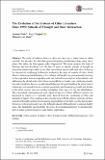Files in this item
The evolution of the systems of cities literature since 1995 : schools of thought and their interaction
Item metadata
| dc.contributor.author | Peris, Antoine | |
| dc.contributor.author | Meijers, Evert | |
| dc.contributor.author | van Ham, Maarten | |
| dc.date.accessioned | 2018-08-01T08:30:11Z | |
| dc.date.available | 2018-08-01T08:30:11Z | |
| dc.date.issued | 2018-07-31 | |
| dc.identifier | 253407719 | |
| dc.identifier | 8f00c00d-e581-447f-9b8b-d7728bc40c0e | |
| dc.identifier | 85051129226 | |
| dc.identifier | 000469956100007 | |
| dc.identifier.citation | Peris , A , Meijers , E & van Ham , M 2018 , ' The evolution of the systems of cities literature since 1995 : schools of thought and their interaction ' , Networks and Spatial Economics , vol. First Online . https://doi.org/10.1007/s11067-018-9410-5 | en |
| dc.identifier.issn | 1566-113X | |
| dc.identifier.other | ORCID: /0000-0002-2106-0702/work/64697482 | |
| dc.identifier.uri | https://hdl.handle.net/10023/15745 | |
| dc.description | This work was funded through a VIDI grant (452-14-004) provided by the Netherlands Organisation for Scientific Research (NWO). | en |
| dc.description.abstract | The study of relations between cities has long been a major focus in urban research. For decades, this field has grown integrating contributions from many disciplines. But today, the field appears rather fragmented. This study analyses the body of literature that has developed over the last 23 years to identify schools of thought on interurban relationships and to see to what extent these interact with each other. It does so by innovatively employing bibliometric analysis to the study of systems of cities, which allows a bottom-up identification of five schools of thought: one predominantly focusing on the regional or intra-metropolitan scale and centred on concepts of polycentricity; one addressing the global scale with a focus on world city networks; one employing simulation and complexity theories to understand behaviour of agents building the urban system bottom-up; one rooted in (new) economic geography and focusing on growth and decline in the urban system; and, one seeking regularities with respect to city size distributions. The conceptual, methodological and empirical aspects of these different schools are discussed by means of a ‘semantic map’ derived from the vocabulary of titles and abstracts of papers. The coupling of the semantic map with the citation networks of these schools of thought confirms the increasing fragmentation of the field over the last decades. However, in the most recent years, the different schools of thought start to interact slightly more. The desirability and feasibility of a move from multidisciplinarity to interdisciplinarity in urban systems research needs further exploration. | |
| dc.format.extent | 22 | |
| dc.format.extent | 1343170 | |
| dc.language.iso | eng | |
| dc.relation.ispartof | Networks and Spatial Economics | en |
| dc.subject | Urban system | en |
| dc.subject | System of cities | en |
| dc.subject | Urban network | en |
| dc.subject | Bibliometric analysis | en |
| dc.subject | Text mining | en |
| dc.subject | G Geography (General) | en |
| dc.subject | Z665 Library Science. Information Science | en |
| dc.subject | 3rd-DAS | en |
| dc.subject.lcc | G1 | en |
| dc.subject.lcc | Z665 | en |
| dc.title | The evolution of the systems of cities literature since 1995 : schools of thought and their interaction | en |
| dc.type | Journal article | en |
| dc.contributor.institution | University of St Andrews. School of Geography & Sustainable Development | en |
| dc.identifier.doi | https://doi.org/10.1007/s11067-018-9410-5 | |
| dc.description.status | Peer reviewed | en |
This item appears in the following Collection(s)
Items in the St Andrews Research Repository are protected by copyright, with all rights reserved, unless otherwise indicated.

